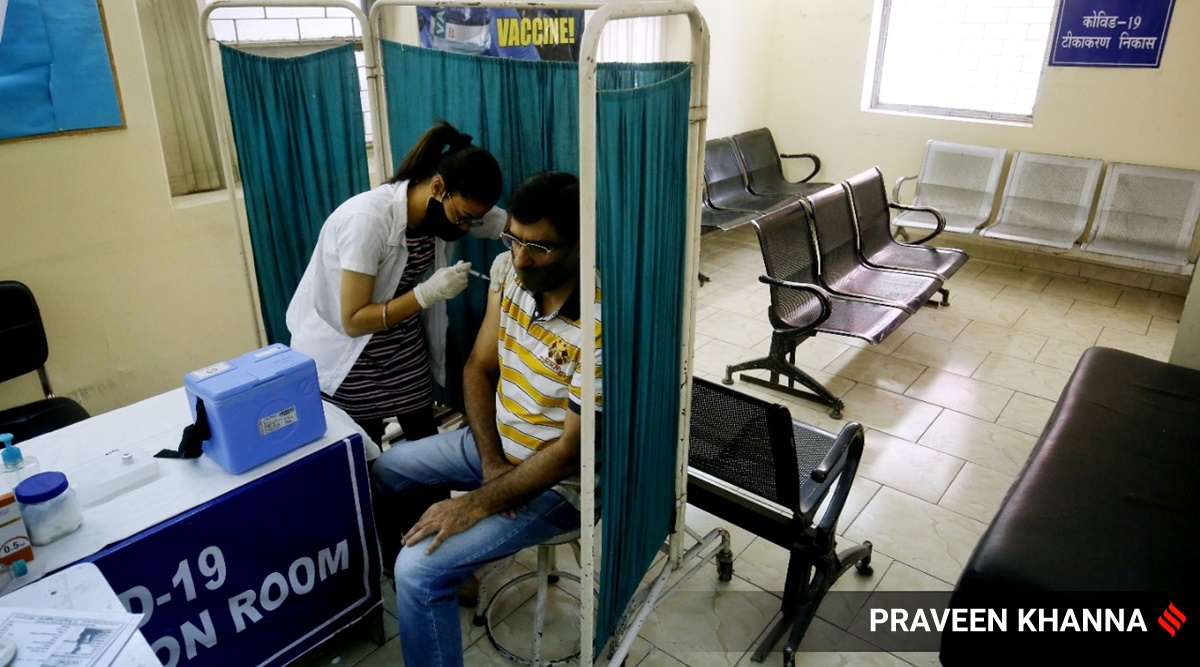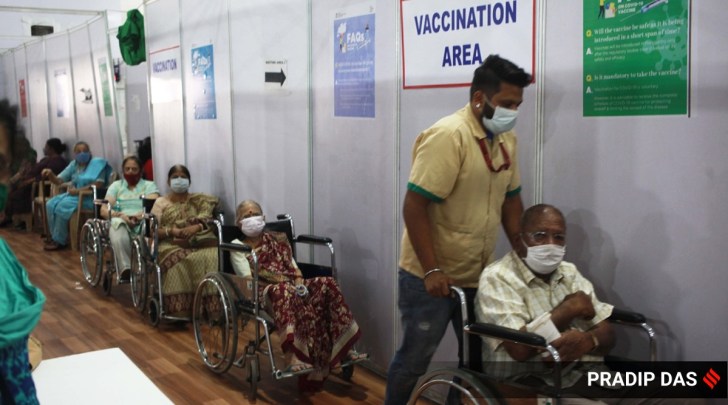 Less number of people came for vaccination at a vaccination center during weekend curfew called by Delhi Government (Express photo/Praveen Khanna)
Less number of people came for vaccination at a vaccination center during weekend curfew called by Delhi Government (Express photo/Praveen Khanna) The government on Monday announced that every person above the age of 18 years will be eligible to be vaccinated against Covid-19 from May 1.
The announcement, one of four significant shifts in the government’s vaccination policy, came at the end of a meeting chaired by Prime Minister Narendra Modi against the backdrop of a relentless surge in coronavirus cases.
States have been given the authority to take a call to open vaccination to any category of people above the age of 18 — a shift from the current policy in which the central government decides on age-specific priority groups for vaccination.
The decision came a day after former Prime Minister Manmohan Singh wrote to Modi on Monday, recommending that states be allowed greater flexibility in vaccine administration, to define categories of frontline workers for vaccination even if they were younger than 45 years, the current cut-off age.
Second, states have been empowered to procure additional vaccine doses directly from manufactures. So far, the Centre has procured all supplies and distributed doses to states to vaccinate priority groups.
Third, 50 per cent of the vaccine supply will now be made available directly in the open market and to state governments for the vaccination programme.
Private hospitals will have to procure supplies of vaccines exclusively from the 50 per cent basket, and at prices determined by the manufacturers. “Manufacturers would transparently make an advance declaration of the price for 50 per cent supply that would be available to State Governments and in open market, before May 1,” the Centre said.
Also, the 50-50 division of supplies between the Government of India and “other than Government of India” channels would be applicable “uniformly across for all vaccines manufactured in the country”.
This means that 50 per cent of supplies of both Covishield and Covaxin will be available in the open market.
Fourth, the Centre has allowed imported, fully ready-to-use vaccines to be entirely utilised in the other-than-Government of India channel. This means that if and when pharma giants like Pfizer bring their vaccines to India, they can directly sell their entire supply in the open market at competitive prices.
 People get the Covid-19 vaccine at a hospital in New Delhi. (Express photo by Praveen Khanna)
People get the Covid-19 vaccine at a hospital in New Delhi. (Express photo by Praveen Khanna)
In the next phase, the Centre will allocate its share of 50 per cent to states based on the extent of infection (number of active Covid cases) and vaccination performance (speed of administration). States are at present receiving vaccine doses based on demand (the number of registrations and walk-in vaccinations).
“Wastage of vaccine will also be considered in this criteria and will affect the criteria negatively. Based on the above criteria, State-wise quota would be decided and communicated to the States adequately in advance,” the Centre said.
“Vaccine manufacturers would supply 50% of their monthly Central Drugs Laboratory (CDL) released doses to Central Government and would be free to supply the remaining 50% doses to State Governments and in the open market,” it said.
The Centre also underlined that vaccinations shall continue as before in “Government of India vaccination centres, provided free of cost” to the eligible population as defined earlier: Health Care Workers (HCWs), Front Line Workers (FLWs), and all people above 45 years of age.
It also said that the second dose of all existing priority groups, “wherever it has become due, would be given priority, for which a specific and focused strategy would be communicated to all stakeholders”.
“India has been following a dynamic mapping model based on availability of vaccines & coverage of vulnerable priority groups to take decisions of when to open up vaccinations to other age-groups. A good amount of coverage of vulnerable groups is expected by April 30,” the Centre said.
 Covid vaccination drive underway at Bandra Kurla Complex (BKC) Jambo Covid Hospital in Mumbai.
Covid vaccination drive underway at Bandra Kurla Complex (BKC) Jambo Covid Hospital in Mumbai.Express Photo By Pradip Das
Monday’s decisions came as concern over the surge gained traction globally, and Britain announced that India was being added to its “red list” – banning all arrivals from this country except for UK or Irish nationals, who must pay to stay in a government-approved quarantine hotel for 10 days on their return.
“In its Phase-III, the National Vaccine Strategy aims at liberalised vaccine pricing and scaling up of vaccine coverage. This would augment vaccine production as well as availability, incentivising vaccine manufacturers to rapidly ramp up their production as well as attract new vaccine manufacturers, domestic and international. It would also make pricing, procurement, eligibility and administration of vaccines open and flexible, allowing all stakeholders the flexibility to customise to local needs and dynamic,” the Centre said on Monday.
On opening up 50 per cent supplies to the open market, it said: “Private vaccination providers shall transparently declare their self-set vaccination price. The eligibility through this channel would be opened up to all adults, i.e., everyone above the age of 18.”
- The Indian Express website has been rated GREEN for its credibility and trustworthiness by Newsguard, a global service that rates news sources for their journalistic standards.

